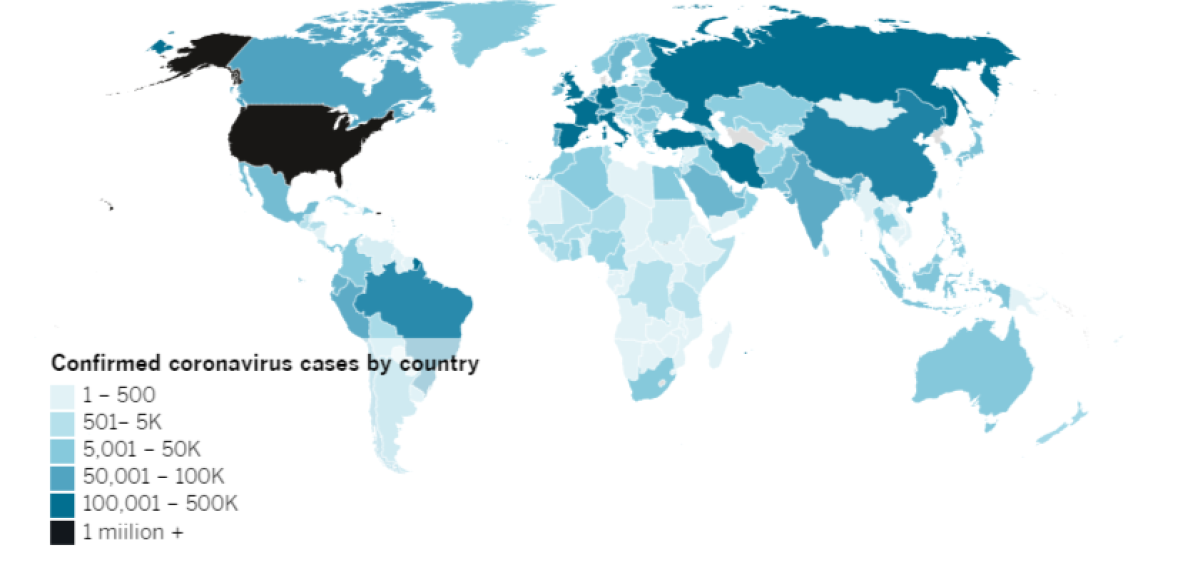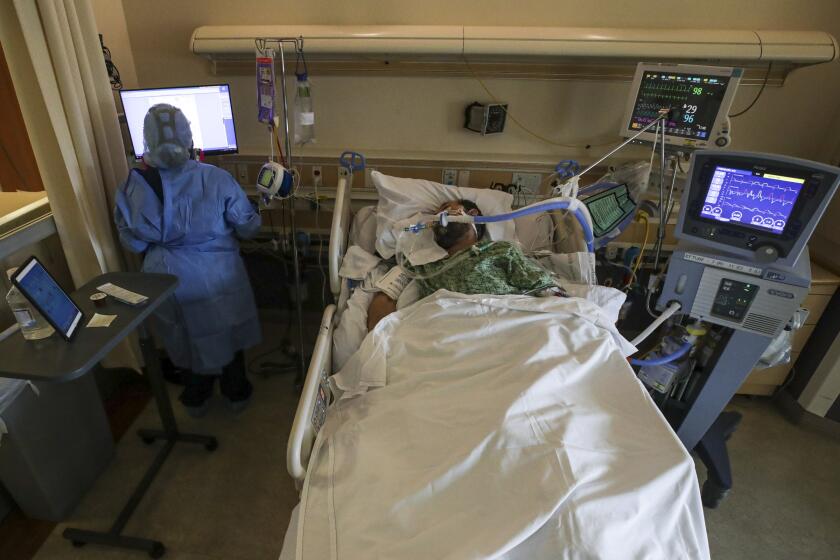Coronavirus Today: West Coast versus everywhere else
Good evening. I’m Diya Chacko, and it’s Tuesday, March 31. Here’s what’s happening with the coronavirus outbreak in California and beyond.
California and Washington had social distancing measures in place sooner than anywhere else in the country. The early action may be paying dividends: The coronavirus has so far spread on the West Coast at a rate slower than in the country’s other hot spots such as New York, New Jersey, Michigan and Louisiana. Now experts are looking to California and Washington for signs that social distancing is making a difference. “If and when [the curve] flattens, you’ll see it here first,” said a UC San Francisco epidemiologist.
That’s not to say the epidemic won’t get worse on the West Coast. Social distancing is reducing transmission of the coronavirus in the Seattle area, but not enough to contain it, according to a new study that found each newly infected person was transmitting the virus to an average of more than one other person. Health officials warned that Seattle’s progress was insufficient and urged residents to redouble their commitment to stay-at-home measures.

Although California isn’t tracking the number of people flouting social distancing orders, Gov. Gavin Newsom has been steadfast in contending that his statewide stay-at-home order should be enforced through persuasion, not punishment, enlisting Californians to pressure one another to stay at home. “That social pressure we’re seeing out there for people to do the right thing is the most powerful enforcement tool we have,” he said Monday.
Locally, city and county officials have been stricter. Los Angeles has shut down all but essential businesses and told residents to stay inside except for shopping, medical appointments and short outdoor activities, orders that could last well into May, Los Angeles Police Chief Michel Moore said.
The Bay Area has extended stay-at-home orders through May 3 and also added new restrictions on residential construction projects and the number of people who can attend funerals. “The incredible sacrifice that everyone has made, I believe it is starting to bend the curve,” said Dr. Sara Cody, the Santa Clara County public health officer. “But it’s not enough and it hasn’t been in place long enough, so we need to keep at it, we just need to keep at it.”
There’s also still a lack of widespread testing, which can mask how many people are actually infected and passing the virus around. The true number “is going to determine how much hospital resources are going to be needed,” a UCLA infectious disease expert said. Hospitals have emerged as the front line in the battle against the pandemic across the country, with a healthcare worker among the new deaths reported in L.A. County on Tuesday.
By the numbers
Cases as of 4 p.m. PDT Tuesday:
Track the latest numbers and how they break down by county and state with our graphics.
Where is the coronavirus spreading?

Your support helps us deliver the news that matters most.
Across California
The number of Californians applying for food stamps jumped to 55,624 in the third week of March, up from 34,882 during the same period last year. The state has asked federal officials to waive a rule that prohibits CalFresh recipients from buying food online for delivery, pointing out that forcing people into stores risks exposing them to the virus and runs counter to the statewide stay-at-home order.
Produce vendors are seeing sales plunge, with many reporting declines of 90% or more as restaurants stop ordering food and as shoppers emptying shelves at grocery stores target dry goods like beans and rice. The widespread drop in demand has rippled through the industry, creating a backlog of tons of produce sitting in walk-in coolers.
To reduce the risk of spreading the virus within crowded prisons, California is granting early release to 3,500 people serving terms for nonviolent crimes and already due to be released within 60 days. There are now COVID-19 cases at 10 prisons, affecting 22 workers and four inmates.
The thousands of LAUSD students not keeping up with schoolwork are worrying education experts who say the pandemic could be worsening already deep inequities that will leave those students far behind their potentially better-resourced peers. The district mainly serves students from low-income families, who rely on schools for support, including meals and mental health. The problem may only be beginning; California’s schools chief says campuses are unlikely to reopen this academic year.
Construction has been proceeding at SoFi Stadium, the $5-billion future home of the NFL’s Rams and Chargers scheduled to open in late July. About 3,000 people — carpenters, crane operators, electricians, iron workers, painters and tile layers — have remained on the job, many grateful for the income but worried it could expose them and their families to the virus.
L.A. County Sheriff Alex Villanueva has been removed as the head of the county’s emergency operations center by the L.A. County Board of Supervisors, who said the change was months in the making and stemmed from an audit that revealed the county was unprepared for the deadly Woolsey fire in 2018.
How to stay safe
— Wash your hands for at least 20 seconds! Here’s a super-fun how-to video.
— Stop touching your face, and keep your phone clean.
— Watch for symptoms including fever, cough and shortness of breath (and possibly the loss of smell or taste). If you’re worried you might be infected, call your doctor or urgent care clinic before going.
— Practice social distancing, such as maintaining a 6-foot radius of personal space in public.
— Only wear a mask if circumstances warrant it. For instance, if you must be in close contact with people in public.
— Here’s how to care for someone with COVID-19, from monitoring their symptoms to preventing the virus’ spread.
How to stay sane
— Was your job affected by coronavirus? Here’s how to file for unemployment.
— Here are all the ways to stay virtually connected with your friends.
— Need groceries? Here’s how to stock up for staying home. You can also watch our video guide on YouTube.
— Visit our free games and puzzles page for daily crosswords, card games, arcade games and more.
— Here are some free resources for restaurant workers and entertainment industry professionals having trouble making ends meet.
— Advice for helping kids navigate pandemic life includes being honest about uncertainties, acknowledging their feelings and sticking to a routine. Here’s guidance from the CDC.
Around the nation and the world
Call it the coronavirus coup. Around the world, as democracies order lockdowns to protect public health, authoritarians are using the pandemic as a pretext for power grabs. The latest comes in Hungary, where Prime Minister Viktor Orban, who was already systemically consolidating power and stifling opposition, now has the authority to rule by decree indefinitely. But analysts see signs of autocratic intent behind executive actions in Israel, Brazil and the Philippines too.
Do “essential” operations include houses of worship? As Easter nears, churches across the country are struggling to navigate a patchwork of social distancing orders.
In Texas, Gov. Greg Abbott issued a statewide stay-at-home order that included churches in the list of essential services. In Louisiana, the pastor who defied state orders outright to hold Sunday services for hundreds has been charged with a misdemeanor. And in Florida, one pastor is torn between his call to the ministry in a time of need and his desire to keep his parishioners safe.
A group of Whole Foods employees nationwide called in sick Tuesday in an effort to press the Amazon-owned grocery chain to provide paid leave for all workers who self-quarantine, hazard pay that would double store workers’ current hourly wage over the course of the crisis, more sanitation supplies and social distancing policies and free coronavirus testing for workers. “We didn’t really ask to be at the front lines of this pandemic,” one employee said.
As passenger demand drops by as much as 90%, some airlines are looking into expanding other services. American Airlines, Delta and United have launched new cargo-only services while dramatically cutting domestic and international passenger flights. Before the outbreak, traditional U.S. airlines generated less than 5% of their overall revenue from transporting cargo.
Your questions answered
Today’s question comes from Peter Ong, who asks: What would senior citizens have to do to mitigate the risk of contracting the virus? Editor Stuart Leavenworth wrote a guide to what seniors and their loved ones need to know.
Many of California’s 5.3 million seniors are at risk for severe illness with COVID-19, requiring them to be extra vigilant to prevent being exposed. Their families and caregivers must also be especially careful.
Older people tend to have weakened immune systems, and most have at least one risk factor, such as diabetes, hypertension or a previous bout of pneumonia. A new study underscores the heightened risk, finding that although the overall fatality rate for people infected with the virus is less than 1%, it is 4.3% for those in their 70s and 7.8% for those 80 or older.
Seniors should take the same precautions as everyone else. That means staying inside, avoiding contact with sick people, limiting contact with others, ensuring that people you live with do the same and of course, washing your hands.
Family members and caregivers need to know what medications seniors are taking and make sure they have an adequate supply of them and other essentials, such as food and cleaning supplies.
Numerous grocery stores have set senior hours to help the elderly shop without long lines, and neighborhood groups and nonprofits, like Laguna Beach-based Sally’s Fund, are working to organize efforts for seniors and deliver services and essential goods safely. And a new Facebook portal lets users request or offer help for their neighbors, such as delivering groceries or running errands.
Got a question? Our reporters covering the coronavirus outbreak want to hear from you. Email us your questions, and we’ll do our best to answer them. You can find more answers in our Frequently Asked Questions roundup, and in our morning and midday briefing.
For the most up-to-date coronavirus coverage from The Times, visit our live updates page, visit our Health section and follow us on Twitter and on Instagram.





